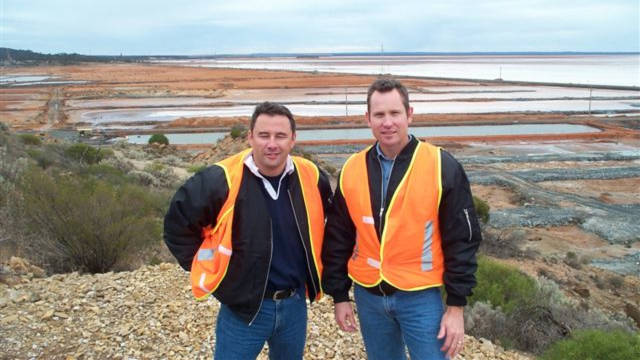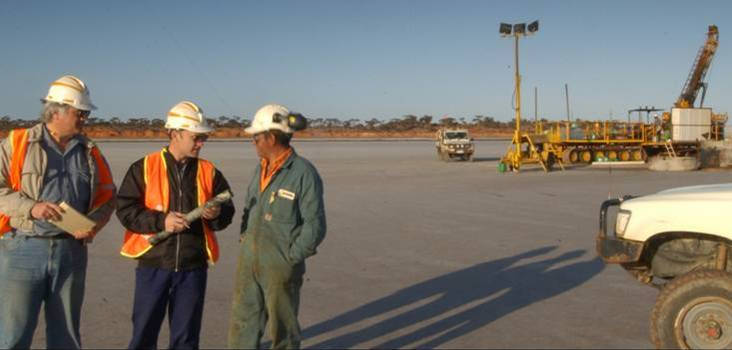The greatest academy on Earth: How Kambalda’s Class of ’98 rose to the summit of the mining industry

The annual staff footy game was a star studded affair
Richard Laufmann, then the manager of Western Mining Corporation’s gold operations in Kambalda, remembers clearly a time in the late 1990s when members of the famous Australian mining company’s high-powered board descended on the rugged WA mining town for a meeting.
There was only one problem. Dust settled on the power lines connecting the site to the grid, causing a pole top fire.
The board members were travelling in the back way from Norseman. Unbeknownst to them the site was draped in complete darkness.
“So the directors came in the back way from Norseman lobbed in the conference room, the whole board, right?” Laufmann, now the CEO of ASX-listed explorer Rex Minerals (ASX:REX), remembers.
“And we’ve got nothing working on site, no lights, no projector for an overhead. And I hadn’t prepared anything or printed anything.
“So I had the PA Sheila (Dunlop) go down and buy a packet of Minties and I said ‘it’s a Minties moment’.
“And we sat and looked at the mill, not turning. Those things struck a chord to me.”
That story was reflective of the down to earth and pragmatic nature of the engineers, surveyors, airleggers, drillers and admin staff working on the site.
It was a defining feature of those days of Kambalda. While WMC’s board quibbled over large lunches in Melbourne’s fancy supper clubs, the people on site got the job done.
No wonder then that it turned out to be one of the greatest breeding grounds for executive talent in the Australian, and global, mining industry.
The Class of ’98
It is a group Ed Ainscough, formerly the chief geologist of the St Ives gold mine under WMC and Gold Fields, now the managing director of Lunnon Metals (ASX:LM8), jokingly refers to as the Class of ’98.
He likened the development of young talent at WMC’s St Ives and Kambalda Nickel Operations to Manchester United’s famous Class of ’92 academy graduates — David Beckham, Gary and Phil Neville, Nicky Butt, Paul Scholes and Ryan Giggs.
A full list would be almost too exhaustive.
But it includes former GM Luke Tonkin, the boss of Silver Lake Resources (ASX:SLR) and previously Sons of Gwalia, Reed Resources and Mount Gibson Iron (ASX:MGX).
People who worked at Kambalda in the 90s went on to lead both major miners and explorers, including Silver Lake Resources, AngloGold Ashanti, Donegal Resources, Northern Star, Pilbara Minerals, Anglo Australian, Anglo American, Lunnon Metals, Mount Gibson Iron, Geoscience Australia, Avoca, Dacian Gold, Hamelin Gold… the list goes on.
Andrew Dinning is head of TSX listed Sarama Resources and formerly COO of Moto Gold Mines which found the 22Moz Kibali deposit in the DRC.
Some remain high up at BHP, which bought WMC out for $9.2b in 2005, including Nickel West northern operations boss Chris Stone and global head of closure Kim Ferguson, one of only five global heads in the world’s largest mining company.
Ian and Leigh Junk, who led the 2000s revival of the Kambalda nickel industry through their company Donegal Resources, were there. So was James Johnson, the CEO of Geoscience Australia, and Rohan Williams, who built gold miners Avoca and Dacian Gold (ASX:DCN).
Like Chris Stone, Pilbara Minerals (ASX:PLS) boss Ken Brinsden was an underground mine manager while Anglo Australian Resources MD Marc Ducler (who built and sold EganStreet Resources to Silver Lake) was a senior metallurgist.
At the nickel operations were Tonkin, commercial manager and Encounter Resources (ASX:ENR) MD Will Robinson, exploration manager and now Hamelin Gold (ASX:HMG) MD Peter Bewick and Silver Lake’s founding MD Les Davis.
While few of the women working on site at the time have moved into senior MD and executive roles, reflective of the barriers still evident within the industry (women were only legally allowed to go underground in the late 1980s in WA), Ainscough remembers around 40% of the geology and exploration team working with him at St Ives being women, many of whom have gone on to senior roles at big companies.
Racquel Kolkert is the director of resources and exploration at Rio Tinto’s Turquoise Hill, which owns the giant Oyu Tolgoi copper-gold mine in Mongolia.
“We supported each other and this made us stronger as individuals and as a team,” Kolkert said of her time in Kambalda when she was named in the Top 100 Global Inspirational Women in Mining while working for Kinross Gold in 2018. “I gained a lot of confidence and saw how effectively teams could work together – both men and women.”
Some well-known names had brief but largely forgotten stints there, including Lion Selection Group fund manager and respected resources analyst Hedley Widdup and legendary Northern Star boss Bill Beament, while Newcrest Mining (ASX:NCM) Sandeep Biswas was running WMC’s Kalgoorlie Nickel Smelter just up the road at the time.
A few giants of the industry came in the period before as well. Mark Cutifani and Tony O’Neill of Anglo American fame cut their management teeth in the nickel business in the early 90s. Megan Clark, the former head of the CSIRO, leader of the Australian space program and a non-executive director at Rio Tinto, was the geo credited with finding the Victory deposit that was the mainstay of the St Ives gold mine in its early years in 1982.
“I could just go on all day, it’s almost like everyone stepped out of St Ives and went on to do bigger and better things. It was quite amazing, they were a really talented, talented team,” Lauffman said.
“I can’t think of a person almost that didn’t go on to achieve a lot and do well … it was way better than the Man United crowd,” Laufmann said.
“Ed just can’t help his bloody British soccer analogies right?”

The perfect site to work on
Ainscough’s not giving up the football analogies.
“We were just lucky that WMC was very good at recruiting good people,” he said.
“When you’re surrounded by good people using the football analogy, if you put a great player or a good player in a really good team, then they can be even better.
“If he’s playing down in the third division and he’s getting hacked and smashed into the ground every five seconds, it’s bit hard to be Ronaldo when you’re playing for Colchester United.”
Kambalda is a well renowned camp, famed for being ground zero of Australia’s first nickel boom when the metal was discovered there by driller Jack Lunnon under directions from legendary late WMC exploration chief Roy Woodall in 1966.
The St Ives gold mines were found in the 1980s, making it one of the few mining domains to house major gold and nickel deposits in the same ground.
In some cases the orebodies were literally intertwined.
The Beta Hunt mine for instance was opened as a nickel operation in 1973 but rumours of airleg miners hiding chunks of unwanted gold from the mine’s caves abounded for years, some thought to be valuable enough to have funded holiday homes in Esperance.
Those rumours were seemingly confirmed after RNC Minerals (now Karora Resources) turned it into a gold mine and blasted two of the largest gold specimens ever found in 2018.
Ainscough said the existence of both major gold and nickel sulphide orebodies in one camp was one reason Kambalda was such a great training ground, but more than that he said it was the company itself.
“It’s not quite as big as some of those global camps, like Voisey’s Bay, in terms of sheer endowment,” he said.
“So you’d have to say that given if it was maybe a second ranking global camp, then it has to be the company really that made the people, it has to be the culture within the company, and the diversity of having two separate commodities so intricately linked and mined essentially by the same company for so long.
“It is a fundamentally globally significant district, but I think probably more the culture of WMC made it a training ground.”
A great place to explore
Justin Osborne, a senior geo at both the Kambalda nickel and gold business, was one of those people.
Now a non-executive director at Matador Mining (ASX:MZZ) and Hamelin Gold, Osborne is best known for his role in the discovery of the multi-million ounce Gruyere gold mine in the Yamarna Belt, 200km east of Kalgoorlie.
“We always had that strong, technical training and strong culture that Roy Woodall had developed over the years with WMC,” he said.
“But what I found with St Ives that it was just a little bit different from some of the other operations, a little bit different from the Kambalda nickel operations.
“I think Bob Watchorn, when he came in as the first chief geologist, was quite a unique individual and was very, very creative and really promoted creativity and innovation.
“And that was on the back of also being just the really good technical training ground for geologists that WMC always was.”
He said the multitude of styles of gold deposits at St Ives made it a remarkable institution.
“For a geologist in that you get exposed to almost every, every conceivable style of orogenic gold mineralisation or greenstone mineralisation that you could think of,” he said.
“There’s more and more deposits of multiple styles and in multiple structural positions and situations. You kind of see everything.
“So you had a unique environment where you had good training and a good culture and a good geological field to draw on.”
While Osborne says some of the creativity in WMC’s exploration left when Woodall left and the company became more focused on economics than discovery, he said one moment with his successor as WMC head of exploration Jack Parry stuck with him.
It came as the geologists were discussing what might happen after the ~100,000oz Argo open pit closed. It turned out to house a 2Moz underground deposit beneath the surface.
“He said ‘don’t get too caught up in the detail, give serendipity a chance’,” Osborne recalled.
“It’s something that’s always remained with me. Whatever we do, however smart we think we’re going to be, and however much planning we put in place, there is always an element of luck in everything we do in exploration.”

St Ives the 20Moz gold field
St Ives passed into the hands of South Africa’s Gold Fields in 2001 as WMC, founded with a small gold operation at Norseman in 1934, began to cut back its non-core assets ahead of what would be a corporate war for the great Australian miner between BHP and X-Strata.
At the time it had just three years of mine life. This month it celebrated 20 years in Gold Fields’ hands, and can be counted as one of a handful of 20Moz gold camps in Australia.
Many of the men and women who made the operations tick in the WMC days stayed on to steer the ship on its new course.
Ainscough remained as chief geologist (his nickel company Lunnon now counts Gold Fields as a 31% shareholder, and owns two nickel mines beneath the St Ives concession).
He had previously been flown to Melbourne to present the case with Rohan Williams for not selling the mine, including to Hugh Morgan, the WMC CEO and Melbourne establishment figure who notoriously signed off on the lowball sale of Australia’s gold reserves during the Howard era as a director of the Reserve Bank.
Within a year the mine was pulling around 600,000oz, Ainscough said.
“I think just after Gold Fields took over for one quarter, we were the second largest gold mine in Australia,” he said.
“I think we pulled annualised, we were at 650,000oz, and they put all these signs up on the lake. It always made me laugh – ‘Australia’s second largest gold mine’.
“And of course, in a couple of quarters’ time we had to take them all down because we just couldn’t maintain that, right? That always used to make us chuckle.”
Ainscough said the big shift was the approach to exploration. WMC owned the largest integrated nickel business in Australia, now BHP’s Nickel West, a large alumina business and the massive Olympic Dam copper-uranium-gold mine in South Australia. St Ives barely rated.
The budget for drilling was so low it kept a lid on ambition. Ainscough said they could not afford to drill a negative hole.
Osborne said WMC was spending just $3m on exploration at its gold business and only half of that at St Ives.
That went up 10-fold when the South Africans entered. The experience taught Osborne and other future executives the importance of putting money into the ground.
“We went from a budget of $1.5m to $15m in a little over a year and proved up the Revenge resources and reserves within a couple of years,” he said.
“So I think having that kind of entrepreneurial spirit and belief that we all had, and it being funded appropriately, it never surprised me that people that were associated with that were going to go on and do bigger and better things.”

A legacy of pragmatism
One thing Laufmann remembers about the WMC days was the pragmatism that translated into the boots on the ground, can-do leadership of the people who worked there.
That often meant pushing the boundaries while butting heads with leadership on the other side of the country.
Laufmann said the mine once installed 3D software that it knew was incompatible with an operating system WMC had tried to standardise across its operations in a multi-million dollar rollout.
He said he and Luke Tonkin also agreed to go mine a pocket of alluvial dirt on the salt lake at St Ives while a group of WMC’s top geostatisticians were in town debating the merits of digging it up. By the time they decided it probably wasn’t a good idea the dirt was already through the mill.
One of the most interesting situations came when the mine’s management decided to close the Victory underground on the eve of Christmas, to be replaced by the Leviathan open pit.
“Melbourne had conniptions. I think they got a request for capital that had to go through in a hurry to meet the contract ramp up for the open pit,” he said. “I forget the number but let’s say it was $194 million.
“And you know Melbourne works to a different heartbeat to the operations. So they got the request for capital which goes through a torturous path of approval in the company.
“Anyway, it lands in Melbourne on the 24th and I’m ringing up on the 24th of December, (CFO) Don Morley saying where’s the request for capital approved?
“Melbourne’s already knocked off right? That’s it, it’s Christmas. What do you mean 24th December … if you don’t sort that on the 24th of December mate there is going to be no gold when you come back in January.”
At Stockhead, we tell it like it is. While Lunnon Metals and Matador Mining are a Stockhead advertisers, it did not sponsor this article.

UNLOCK INSIGHTS
Discover the untold stories of emerging ASX stocks.
Daily news and expert analysis, it's free to subscribe.
By proceeding, you confirm you understand that we handle personal information in accordance with our Privacy Policy.








